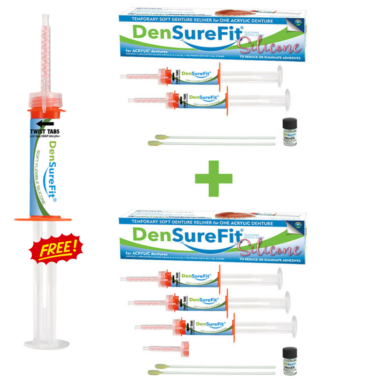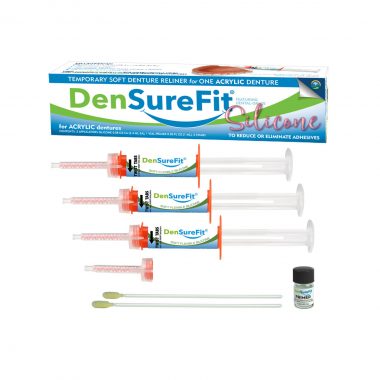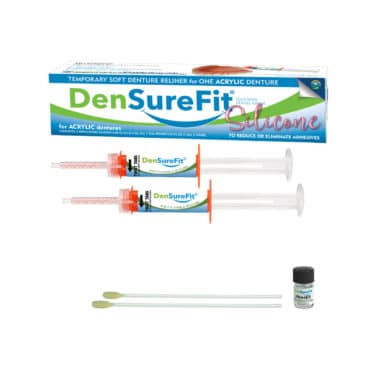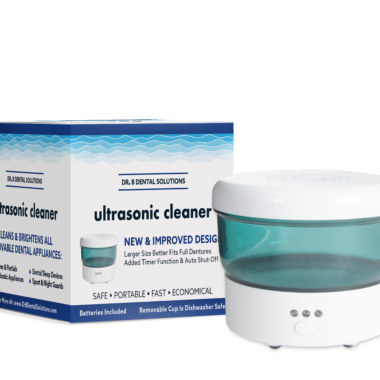DenSureFit
Instruction Guide
How to Apply DenSureFit Soft Silicone Reline Material
Dentist-grade soft silicone denture reline material
Follow Instructions Exactly for a Successful Reline
Please review all instructions carefully before attempting your reline. The contents of the kit are intended for one denture plate.
CAUTION:
Do not use immediately following extractions. Consult your dentist before using!
Acrylic Dentures
DenSureFit is for use on ACRYLIC dentures. Not for use on alternative denture materials.
Applying over a soft professional reline?
If so, please follow “SNUG-UP Application” instructions.
Do you have a partial denture?
If so, these instructions are also for you. Pay close attention to the variation for seating a PARTIAL.

DenSureFit Instructions
Table of Contents:
DenSureFit works on the principle of suction.
DenSureFit is not adhesive or like adhesive. DenSureFit is a silicone liner that will remain on your denture for 3 months or longer and is intended to make your denture fit snug enough to create suction which holds the denture in place.
DenSureFit is meant to be layered.
Each kit is intended to reline ONE denture plate. For the upper denture, most wearers need 2-3 silicone applicators/layers to get the dentures snug (DO NOT apply more than 1 layer to the palate). On the lower denture, 1-2 silicone applicators/layers is normal. If your dentures are still loose, they likely need another layer of silicone. See Upper Snug Up and Lower Snug Up for details.
DenSureFit is buildable.
You can add additional layers of silicone on top of previous layers whether day 1, day 10, or day 30. However, you must clean the denture each time, add primer if needed to bare spots, and then apply additional silicone according to the Upper Snug Up and Lower Snug Up Instructions.
 Primer application is very important.
Primer application is very important.
The primer is the bonding agent that allows the silicone to adhere to the hard acrylic denture. The silicone cannot adhere to the denture without the primer. You must apply primer inside the denture but also on the ridges and over the ridges to anchor and secure the edges of the silicone over the top ridges of your denture. Without proper coverage of primer, the silicone may lift on the edges and shorten the life of your liner. Primer is only necessary before the initial layer of silicone and on any bare patches, thereafter. Once the denture is covered with silicone no more primer is needed. The new layer of silicone will adhere to the previous layer. See Step 2: Apply Primer for details.
 DenSureFit is intended to cover the entire inside of your denture,
DenSureFit is intended to cover the entire inside of your denture,
but also to travel up the side walls and to wrap around the top ridges of your denture. This is what creates the seal and the suction and keeps food and debris out from under the liner. This is called “flashing.” See the instructions later in this guide for specific details.
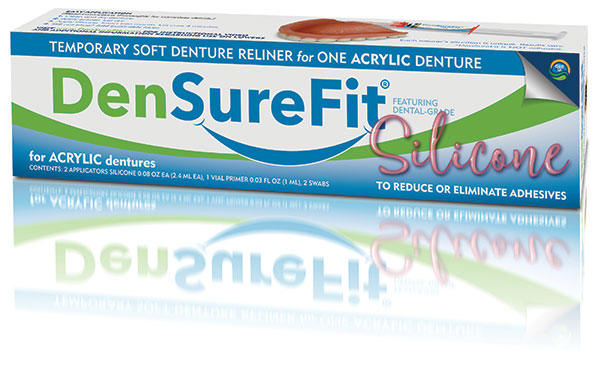
All DenSureFit kits are the same product,
and can be used on either the upper or lower denture and each kit is intended to reline ONE denture plate. The difference in the upper and lower kit is simply the volume of product in each kit. The upper kit includes three silicone applicators and the lower kit includes two silicone applicators.
 Upper denture first
Upper denture first
If you have an upper and lower denture you need to line your upper denture first. You need a great fitting upper (with no adhesive necessary) before you can line your lower denture. The upper denture is needed to properly “seat” your lower denture. If your upper is “off” then your lower will be “off”. This guide will provide all of the details needed for a successful reline for your uppers and lowers.
Before You Begin
Understanding how to handle each piece of your kit is CRITICAL to avoid wasting your product.
Be sure to read this entire guide before you start.
What You’ll Need
In addition to parts included in your kit, it will help to have the following items on hand:
- A clean, dry towel
- Dish soap
- Rubbing alcohol & cotton balls/pads
- Scissors
- A timer or stopwatch
Inside The Kit
Primer (½ bottle)
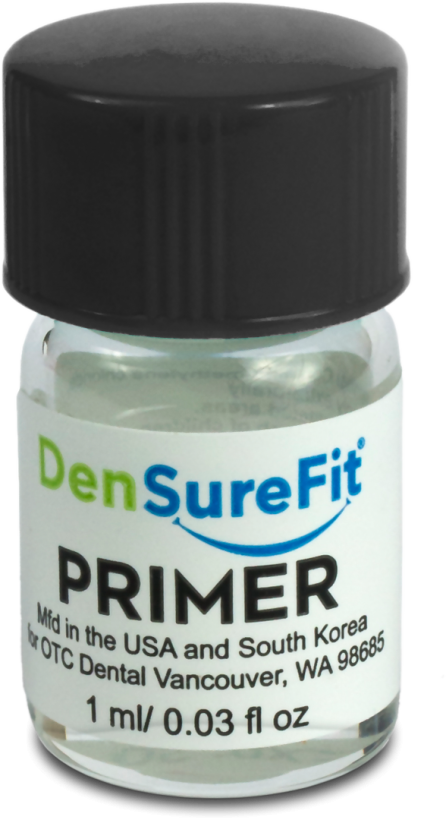
IMPORTANT!
When you dip the swab into the primer, REMOVE IT QUICKLY! The primer is highly absorbent- DO NOT leave your swab in the primer or dip it more than once. If you do, it will soak up ALL the primer and you will NOT have any primer left for later. One quick dip is the perfect amount to primer one denture plate.
Replace the cap tightly and immediately after use. Store your DenSureFit primer tightly capped and upright in a cool place to prevent evaporation.
Inside The Kit
Primer Swabs
- Use each primer swab only once.
- Quickly dip the swab ONE TIME ONLY and REMOVE IMMEDIATELY from the primer!
Silicone Applicators (x2)
The silicone goes on after the primer coat.
It’s the magic that makes your denture snug like never before.
- DO NOT twist/open your silicone applicator until you are ready to apply it to your denture! Otherwise, it will dry out and you’ll waste your silicone.
- WHEN IT’S TIME TO OPEN, locate the black arrow on the tube. Hold orange barrel still and firmly in one hand. With other hand, TWIST clear tabs on the tip in the direction of the arrow (clockwise) until you hear/feel the “click”. If it does not click, or if you twist opposite the arrow, your silicone may squeeze out of the sides of the applicator tip and become unusable.
- Use ALL the product in one applicator to reline one denture plate. The second applicator is for a SNUG-UP application. Most people require 2 applicators to get snug.
- Use only one applicator of silicone at one time (i.e., one for each application). After 4 minutes of curing time, assess your fit. If you’re not snug, you can add another applicator of silicone over the top of the first layer. (Follow Snug Up instructions for placement.)
Know the Anatomy of Your Denture
IMPORTANT!
It is CRITICAL you understand and apply these concepts to create a proper fit. You have ONE SHOT to get your foundation layer right. If you don’t, you’ll need to peel out the material and start over.
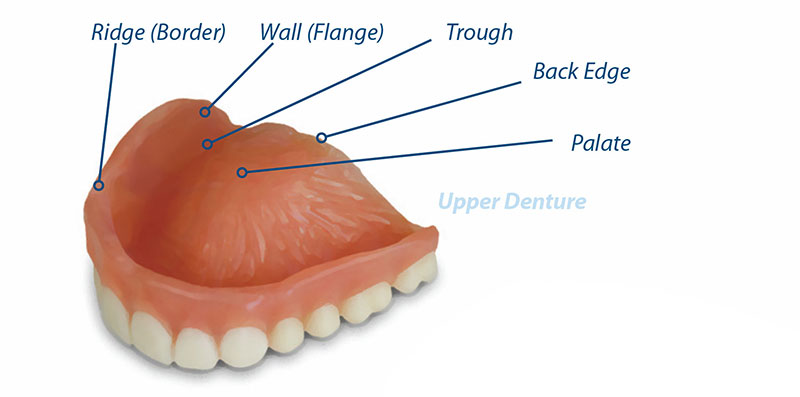
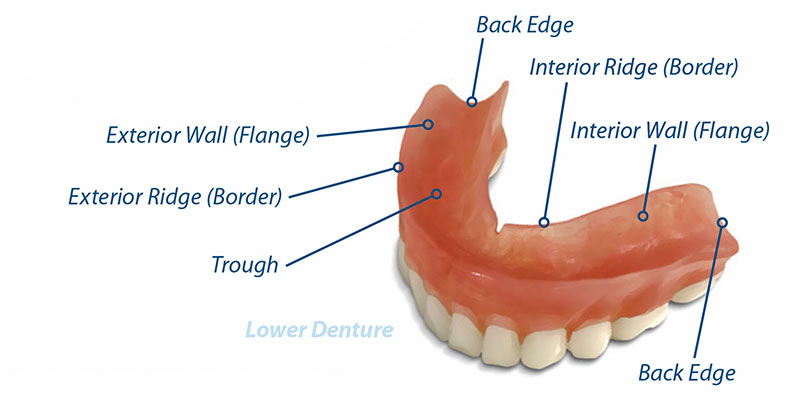
Please identify the parts of your own upper denture before applying DenSureFit.
How to Ensure Your Proper Fit:
SEAT your denture in your SUCTION SPOT!
DenSureFit works by suction on the upper denture. That suction happens in your suction spot in the roof of your mouth. Your roof
barely changes, so it is always going to be your reference point. When your denture is seated properly in your suction spot during
your reline, the silicone is forced to fill the voids in your gum line in precisely the right spots so that your denture STAYS SUPPORTED in your suction spot.
It’s CRITICAL that you seat your denture snugly in your suction spot.
Think of how a suction cup works. All the air needs to be pressed out before suction can happen. Your denture works the same way! There can be no air pockets between your denture and the roof of your mouth.
Before you use DenSureFit, PRACTICE finding your SUCTION SPOT!
- First, practice with your denture out of your mouth. Wrap your finger around your nose and give your thumb a few nice sucks. Feel where the curved pad of your thumb get suctioned in that curved part of the roof of your mouth? That’s your SUCTION SPOT and THAT is where you need to firmly seat your denture. Don’t push back toward your throat, don’t push forward toward your front teeth, just push straight up to the roof of your mouth.
- Now, place your denture in your mouth and suck your thumb, mouth closed around your thumb. This is where you should seat it during your reline.
NOTE: While many people have natural mouth and denture contours and conditions to achieve good suction, some do not. Not every wearer will be able to achieve good suction. If this is your situation, it is still CRUCIAL that you seat your denture properly in your suction spot.

DenSureFit Procedure
Upper Reline Instructions.
Step 1: Clean, Rinse and Dry Your Denture
If you don’t clean and dry your denture completely prior to
application, DenSureFit will not stick!
For best results, wash your denture with dishwashing soap, dry with a clean towel, then allow it to air dry thoroughly. NOTE: Adhesives (especially waterproof types) can leave a residue on your denture. It’s important to clean off this “invisible” residue before starting your reline. Denture cleanser is NOT sufficient for this job of prepping your denture prior to relining.
PRO TIP: After washing/drying your denture, wipe the inside with rubbing alcohol on a cotton ball until it is squeaky clean.
Step 2: Apply Primer to the Denture
Primer is the bonding agent necessary to allow the silicone to adhere to the hard acrylic denture surface. Without primer, the silicone cannot stick. IMPORTANT: Primer needs to be applied to the entire interior of the denture, but also ON the ridges and OVER the ridges (1/4 inch) to get the silicone to wrap around the entire denture. This is what creates the seal and the suction to keep your denture in place. Without proper coverage of primer, the silicone will not stay put, and will lift prematurely. Review Anatomy of a Denture.
a. Open your primer bottle and quickly dip your swab in and out of the bottle one time only. The longer the swab is immersed the more
primer will be absorbed and wasted.
b. Close your primer bottle tightly.
c. Use the primer-covered swab to gently paint your denture with primer in a thin, even coat.

d. Starting with the inside top perimeter of your denture, cover every spot on the denture ridge, slightly over the ridge on the front, wall, palate, trough, and along the back edge (as indicated by blue area). Missed spots may cause the silicone to lift.
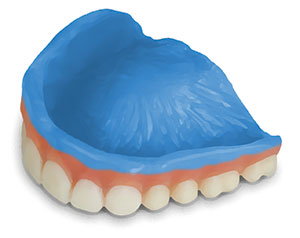
e. Grab your timer; let the primer dry for two minutes.
Step 3: Activate Silicone Applicator
a. Remember: Do NOT activate the applicator OR press the plunger until you are ready to apply the silicone to your denture.
b. You have approx. 15 seconds to work with the silicone before it starts setting up.
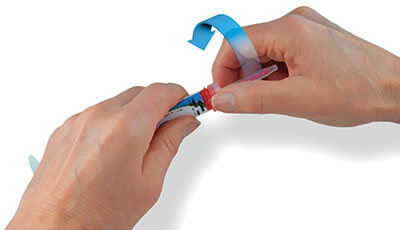
c. Hold the orange base of the applicator securely in your non-dominant hand, then with your other hand, twist the clear winged tabs IN THE DIRECTION OF THE BLACK ARROW (clockwise) until you hear/feel it snap into place. (If silicone squishes out the sides, you have twisted the tabs the wrong way! Discard and use a new applicator.)
Step 4: Apply Silicone to Your Denture
Apply three lines of silicone to the palate, and the remainder in the trough.
IMPORTANT! Work quickly to get the silicone onto your denture and into your mouth in about 15 seconds.
The lines do not have to be neat, pretty or perfect. Just get it onto your denture and into your mouth QUICKLY so the silicone does not start setting up outside of your mouth. You need it to spread in your mouth in its most fluid state to get a proper impression for your best fit.
Step 5: Seat Your Denture
Have your timer ready; timing is critical!
a. Immediately insert your denture into your mouth with your thumb (index finger over your nose). Give your thumb a couple nice sucks to suction your denture into your suction spot.

(DO NOT remove your denture during the 4 minutes!)


Step 6: Assess Fit
a. Examine the silicone on your palate. You’ll need to ensure your foundation is good before moving on. Did the silicone make a true
impression of the roof of your mouth? If so, you can proceed. But if you see humps where lines of silicone did not spread thinly and evenly on your palate, this is an issue. If this is your case, do NOT do a Snug-Up. You will need to remove the silicone and start fresh. Contact DenSureFit for assistance.
b. Examine where the silicone ended on the wall. If the silicone did not reach the top of your wall to create “flashing” (excess overlap) that extends up and over the ridge, your voids are not yet completely filled. Proceed to the Snug-Up Application on page 11. (Ideally, you want even flashing of the silicone on the ridge of your denture. Flashing indicates that voids are filled and provides a nice seal. Even though flashing is desirable, it is not always necessary for a great fit.)
Remember… your ideal fit can only happen once all your voids are completely filled. These voids must be filled with the denture properly seated in your suction spot. When this happens, an accurate impression of your mouth is created and the denture can then STAY SUPPORTED up in your suction spot.
SNUG
If your denture stays up and is snug and comfy, you are done! Don’t wear your newly-relined denture for 2 hours as it needs to finish curing outside of your mouth in a glass of water or cleaner.
NOT SNUG?
If your denture does not feel snug, don’t worry… you are NORMAL! Most wearers with medium looseness require 2 silicones for complete snugness. If they’re significantly loose, a third silicone application is likely needed.
PRO TIP: DenSureFit silicone is BUILD-ABLE! It will adhere to itself WITHOUT primer. As your denture loosens over time, you may apply more silicone to your previous layer using the Snug-Up application. You DO NOT need to remove and reapply your previous layer as long as it’s in good condition and not lifting.
Make sure your previous layer of silicone is perfectly clean and dry before adding a new layer, or it will not adhere properly.
DenSureFit Procedure
Upper Snug-Up Application.
Use these SNUG-UP instructions to snug up your denture AFTER your initial application of DenSureFit or if you are applying DenSureFit over a SOFT PROFESSIONAL RELINE.
Step 1: Clean, Rinse and Dry Your Denture
If you don’t clean and dry your denture completely prior to
application, DenSureFit will not stick!
For best results, wash your denture with dishwashing soap, dry with a clean towel, then allow it to air dry thoroughly. NOTE: Adhesives (especially waterproof types) can leave a residue on your denture. It’s important to clean off this “invisible” residue before starting your reline. Denture cleanser is NOT sufficient for this job of prepping your denture prior to relining.
PRO TIP: After washing/drying your denture, wipe the inside with rubbing alcohol on a cotton ball until it is squeaky clean.
Step 2: Prime Bare Spots
a. Prime any bare spots of hard acrylic that did not get covered by silicone on the top of the ridge, slightly over the front of the ridge, and on the back edge of the palate. It is not necessary to prime over DenSureFit silicone. The silicone will adhere to itself without primer. DO NOT cover existing silicone with primer.
b. Let primer dry for 2 minutes.

Variation for Applying PRIMER Over Soft Professional Reline:
Apply primer over ALL of the soft reline material EXCEPT on the top of the palate. You will only need to prime ¼ of the way up the palate.
Step 3: Apply Silicone to the middle of wall above the trough
Apply silicone mid-way up the wall just above the trough area (no other location).Work quickly to get the silicone onto your denture and into your mouth.
IMPORTANT: Do not apply silicone to the palate on a snug-up or over a soft professional reline! If you do, you will over-build the palate and your fit will be ruined.
How much silicone to apply? Use 1/2 an applicator (or 1 line of silicone) if a minor snug-up is needed. Use 1 full applicator if your denture is still moderately loose.
Exception: Bare spots on the back edge. IF the silicone has not extended all the way to the back edge of the palate and there are bare spots of acrylic, apply a very skinny line at the back edge.

Step 4: Seat Your Denture
a. Insert denture into your mouth with your thumb (finger over nose) and give your thumb a couple nice firm sucks so it suctions up in your suction spot.

c. Assess fit. If it’s snug, you’re done!
d. If it is not snug, examine the silicone as you did on Upper Reline Step 6: Assess Fit to determine if all your voids are filled. If not, repeat the Snug-Up application using another ½ or whole applicator of silicone (depending on how much void you still need to fill).
DenSureFit Procedure
Lower Reline Instructions.
For complete instructions on cleaning, priming, and activating the silicone applicator, click here.
Have an UPPER and LOWER?
Do not attempt to reline your lower plate until your upper fits properly. Always reline your upper FIRST and then your lower. Do NOT reline them both at the same time.
Please review Upper Reline Instructions or click here.It is CRITICAL that your UPPER fits PROPERLY without adhesivebefore
you reline your lower to ensure a proper bite. Always
reline the UPPER before the LOWER.
Step 1: Clean, Rinse and Dry Denture
Clean, rinse and dry your denture (click here).
Step 2: Apply PRIMER and let DRY 2 minutes.

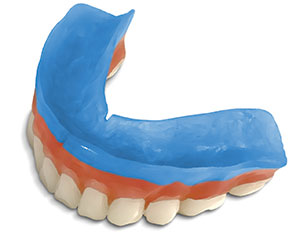
Step 3: Apply Silicone

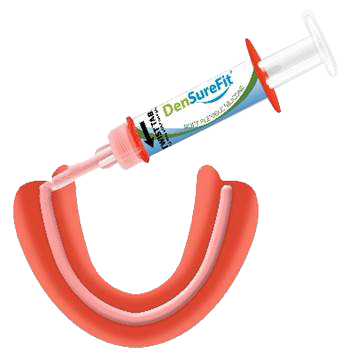
Step 4: Seat Denture
- If you wear an upper denture, put that in your mouth to properly seat your lower denture.
- Lightly place the lower denture onto your lower gum line and bring your back teeth together in a natural biting position. DO NOT use your fingers to seat your denture. DO NOT bite down hard and fast, or all the silicone will squirt out of the area where needed.
- Quickly check your bite in the mirror. Ensure your upper 2 front teeth are lined up with the lower 2 front teeth.
- Now bring your back teeth together into a “light clench” with medium pressure and hold for 4 minutes.
Step 5: Assess Fit
After the 4 minutes, assess your fit.
SNUG
If your denture is snug, you are done. Leave your denture to air dry outside of your mouth for 2 hours (in a glass of water or cleaner) before wearing while it finishes curing. See back of booklet for trimming and care instructions or click here.
NOT SNUG?
Examine the silicone in your denture.
Did the silicone flash up and over the ridge all the way around?
If the silicone did not extend over the ridge at the top of the wall at any point, you may need more silicone to finish filling your voids. Proceed to the Snug-Up Procedure or click here.
If the silicone flashed all the way around the edges of your denture, then you have filled all the voids and you have a nice seal. This is likely the best fit that you are able to achieve. Use powder adhesive on top of your lining if you need extra security.
Issue with a “floating” lower denture?
DenSureFit will do its job of filling the voids that are making your denture loose. Even after the voids are filled, your denture may still want to “float” off the gum line. If this is your issue, use a powder adhesive to help keep your denture secured on your lower gum line.
DenSureFit Procedure
Lower Snug-Up Application.
Snug-Up Procedure For Lower Denture
If needed, use these instructions to snug up your lower denture immediately following your initial application or later if your denture gets loose.
DenSureFit silicone is build-able. If your denture gets loose after a good initial fit and your liner is in good condition, you can layer more silicone on top of your existing liner.
Step 1: Clean and Dry Denture
- Ensure your denture is perfectly clean and dry as you did in your initial application.
- Wipe down the inside of the denture with rubbing alcohol and let dry.
Step 2: Prime Bare Spots
- Dip a cotton swab (not the swab we provided) into the primer and use that to prime any bare spots of hard acrylic on the ridge and slightly over the ridge. The reason for the cotton swab is because you need very little primer to prime bare spots. The foam swab in your kit will use more primer than you need. Do not cover existing DSF silicone with primer. It will not harm the silicone, it is just not necessary because the silicone will adhere to itself without the primer.
- Let the primer dry for 2 minutes.
Step 3: Apply Silicone

silicone on to your denture and into your mouth. This is especially important on the Snug-Up application because the thinner the lines of silicone, the faster it will set up. If you take too long, the new layer will set up and not meld to the previous layer of silicone.
Step 4: Seat Denture
- If you wear an upper denture, put that in your mouth to properly seat your lower denture.
- Lightly place the lower denture onto your lower gum line and bring your back teeth together in a natural biting position. DO NOT use your fingers to seat your denture. DO NOT bite down hard and fast, or all the silicone will squirt out of the area where needed.
- Quickly check your bite in the mirror. Ensure your upper 2 front teeth are lined up with the lower 2 front teeth.
Now bring your back teeth together into a “light clench” with medium pressure and hold for 4 minutes.
Don’t Wear Your Newly Relined Denture For 2 Hours!
After you have achieved a snug fit, let your newly lined denture finish curing for 2 hours out-side of your mouth (can be placed in water or cleaner). It is not necessary to wait 2 hours between applying snug up layers.
DenSureFit Procedure
Trimming & Care.
Trim Excess Silicone (optional)
If you have a great fit, but feel like you need to trim extra silicone hanging around the edges of your denture (flashing), keep in mind that over-trimming can break your suction.
When to Trim:
- Trim if silicone is loose, hanging or uncomfortable.
- Trim if you can see silicone showing when you smile.
When NOT to Trim:
- Do not trim flashing if it feels comfortable. It is important for a good seal.
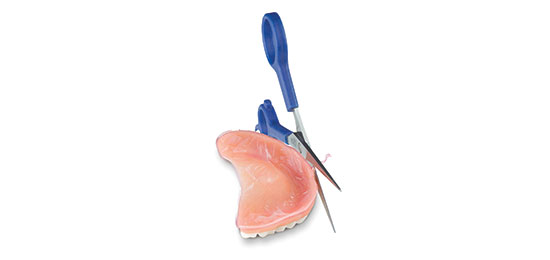
How to Trim:
- Only trim on the FRONT of your denture, above the teeth. NEVER trim directly on top of the ridge you will break the suction seal.
- It is desirable to have a small amount of flashing on the back edge of the palate. If it is not bothering you, leave it alone. If it is uncomfortable, go ahead and trim, but leave a small amount of flashing coming off the back edge. Hold your scissors at a 45° angle, angled away from the palate. This keeps the silicone against the roof of your mouth, maintaining a seal.
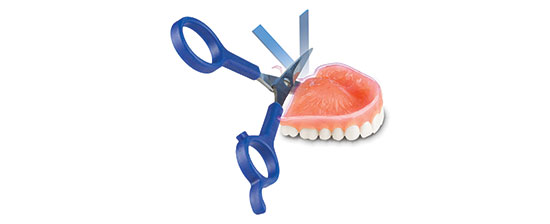
Trimming a Lower
To trim inside a tight curve on a lower denture, keep the scissor blade CLOSED and run the closed blade downwards on the silicone inside the curve to remove the excess.
Care
It is important to know that while the DenSureFit liner stays in your denture, you should still remove your denture every day to soak your denture in a denture cleanser and to allow your gums a chance to breathe.
Cleaning Your DenSureFit-Lined Denture
- Soak/clean your DenSureFit-lined denture in a regular denture cleanser every day to remove bacteria.
- Denture cleansers intended to remove tough stains like smoking stains can be harsh on the silicone if used on a daily basis. If you use them, we recommend you use them once weekly and a regular cleanser the other days in order to extend the life of your liner.
- It is okay to store your denture in clean water when you are not wearing them.
Brushing Your Liner
- After soaking your denture in your denture cleanser, you should also gently brush your liner with a soft-bristled toothbrush. Use soft bristles to avoid microscopic tears in your liner.
- Take care when brushing around the edges of the silicone so they do not lift prematurely.
Powder Denture Adhesive
Some people need the extra security of an adhesive on top of their DenSureFit lining. This is likely for those with much bone/tissue loss on the upper, flat palate situations and on lower plates. If you need to use adhesive on top of your DenSureFit liner, powder adhesive will adhere best to the DenSureFit silicone.
Removing Your Densurefit Liner
Most people remove and replace their DenSureFit liners after 3 months. When it is time to remove it, lift an edge and slowly peel the silicone away. A dull, safe tool such as a wooden cuticle pusher may be useful to get underneath the silicone for help with removal.
A rougher or more porous denture surface will cause the silicone to adhere stronger than a smooth, finely polished surface making it tedious to remove. Please click here more information on removing a liner that is stubbornly adhering.
Need Help?
Email us! [email protected]
Call us! 844-682-3368 Mon-Fri (8am-5pm, Pacific Standard Time)
Click here to read Frequently Asked Questions.
We believe DenSureFit will provide you with the best fit you’ve ever had with your dentures.
We are 100% committed to your success.
Dentist & Customer Approved
Trusted By Thousands Of Customers
“I can eat things now that I couldn’t before, without worry or concern. They fit with a seal and suction that gives great confidence. Thank you!”
“With DenSureFit, I just give my denture a quick soak and light brushing and I’m done! No more sticky glue issues!”
“Once you try the product ONE TIME, you will never return to what you have been using! DenSureFit IS the BEST product for ANY denture wearer!”
-
Sale!
Upper & Lower Denture Reline Kit
Original price was: USD $114.98.USD $91.98Current price is: USD $91.98. Add to cart -
Upper Denture Reline Kit
USD $64.99 Add to cart -
Lower Denture Reline Kit
USD $49.99 Add to cart -
Sale!
Ultrasonic Denture Cleaner
Original price was: USD $29.95.USD $24.95Current price is: USD $24.95. Add to cart

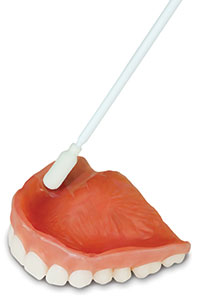 Primer application is very important.
Primer application is very important.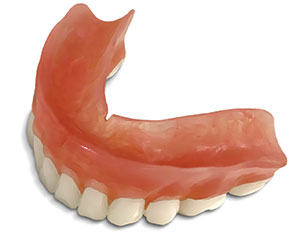 Upper denture first
Upper denture first


